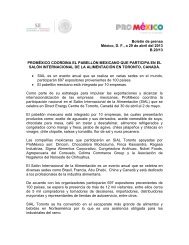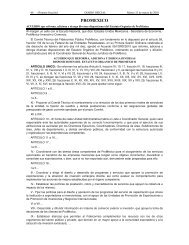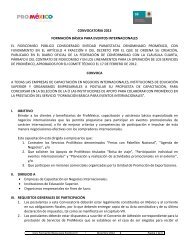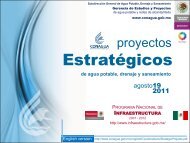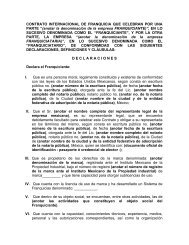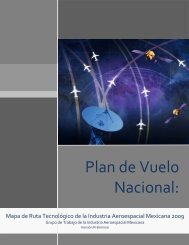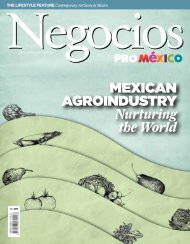ASiAn invASion wElcomEd - ProMéxico
ASiAn invASion wElcomEd - ProMéxico
ASiAn invASion wElcomEd - ProMéxico
You also want an ePaper? Increase the reach of your titles
YUMPU automatically turns print PDFs into web optimized ePapers that Google loves.
56 Negocios i The Lifestyle photo courtesy of kurimanzuto<br />
Dr. Lakra,<br />
the tattoo of<br />
contemporary art<br />
Jerónimo López Ramírez, who is better known as Dr. Lakra, has<br />
combined the worlds of tattooing and painting into a new art form.<br />
By superimposing provocative tattoos of demons and erotic shapes<br />
on magazine images from the 1950s, Dr. Lakra has inked a unique<br />
place in contemporary Mexican art.<br />
A collection of magazines and posters from<br />
the 1950s, ink and his uniquely creative concept<br />
have turned Jerónimo López Ramírez<br />
–better known as Dr. Lakra– into one of the<br />
most important exponents of contemporary<br />
Mexican art.<br />
With the mind of a surgeon and the hands<br />
of a tattoo artist (his original job), López (born<br />
in 1972 in Mexico City) has created work<br />
that intervenes itself among old images –the<br />
majority of which are charged with eroticism<br />
that seemed incendiary when he was<br />
just beginning and is still very provocative<br />
nowadays. On the bodies of nude or seminude<br />
women who were eager to exhibit their<br />
roundness, the painter creates posthumous<br />
tattoos, drawing demons, sexual organs and<br />
false teeth. It is an exercise many passersby<br />
have mischievously done on images found on<br />
the streets.<br />
“As pertinent as graffiti, the relative innocence<br />
of the other is politicized and the images<br />
are seasoned with a diabolical condiment.<br />
Embellishment or social identification, the<br />
works are a carnival of the grotesque. The<br />
erotic firecrackers, the ancient ritual and the<br />
hallucinogenic visions are established in a<br />
collage of ideologies,” asserts the presentation<br />
text of an exhibition by López at The<br />
Saatchi Gallery in London.<br />
As the resident artist at Kurimanzutto,<br />
the prestigious Mexican contemporary art<br />
gallery, Dr. Lakra’s works have traveled from<br />
England –The Saatchi Gallery, Tate Modern<br />
Kate MacGarry– to Japan, having passed<br />
through the cities of Vienna, Madrid, Castilla,<br />
Lisbon, San Francisco and New York.<br />
The last crop of iconographic interventions<br />
resulted in the book Health & Efficien-<br />
cy (editorial RM, Mexico City, 2009). It is a<br />
series that was partly inspired in a handful<br />
of old magazines about nudist camps that Dr.<br />
Lakra bought one rainy Sunday in a market<br />
on Brick Lane in London. With Chinese ink,<br />
tattooing needles, pencils, vinyl paint and<br />
white gouache (an opaque watercolor), the<br />
artist created demons to conquer the bodies<br />
of the women who were photographed in<br />
the 1950s for those magazines.<br />
In addition, the artist’s work can be found<br />
on human skin. Born in Mexico City but having<br />
lived in the city of Oaxaca for several years now,<br />
López is recognized for his work as a tattoo artist.<br />
It was what opened the door to the world of<br />
painting. Without a doubt, he assures that tattooing<br />
and painting are distinct disciplines.<br />
—How did Jerónimo López<br />
Ramírez become Dr. Lakra<br />
—At the end of the 1980s, between 1988<br />
and 1989, I would frequently go with my<br />
friends to the Chopo flea market (in Mexico<br />
City). I decided between 1991 and 1992 to<br />
become a tattoo artist and draw on human<br />
skin at my house or at the homes of my<br />
friends. Of course, I was already tattooed.<br />
To do my job,I always carried a medical<br />
bag where I would store my needles,<br />
gloves and surgical masks. Everyone told<br />
me I looked like a doctor.<br />
—And how was it that<br />
Dr. Lakra became an artist<br />
—I was already painting and drawing before<br />
I was tattooing. I was doing what I always<br />
did: I never stopped painting. The good<br />
thing was I never had to look for space<br />
to do my work. I knew the people at<br />
Kurimanzutto from before and they invited<br />
me. In reality, I was very fortunate.<br />
—Why do you continue tattooing<br />
—Tattooing and painting are distinct<br />
mediums of expression; they look<br />
alike but can’t be compared. They<br />
combine various arts. I go to tattooing<br />
conventions and everything. On the other<br />
hand, making a living from art is difficult<br />
in Mexico or in any part of the world.<br />
For a long time, I made a living from<br />
tattooing because I couldn’t solely do<br />
it from painting. Now, I combine them<br />
without a problem. In my work, I am<br />
a boat without direction. I go where the<br />
air guides and takes me because in life<br />
one thing (tattooing) took me to another<br />
(painting) and brought me back. Today,<br />
I make more specialized tattoos. I never<br />
stopped working on different things.<br />
—The tattoos you paint in your<br />
artistic work, are they preconceived<br />
like those of your “patients” or do<br />
they emerge while you are working<br />
—I have painted many pictures in which<br />
I knew what I was going to create; for<br />
example, sometimes I want the pieces to<br />
only have tattoos that are used in Russian<br />
prisons. Other times, they are random,<br />
picked by chance.<br />
—Tattoos are seen negatively in<br />
some sectors. Do you think your<br />
paintings have the same effect<br />
—Times have changed. Today, most<br />
people accept tattoos. There is also<br />
a very conservative sector for which my<br />
paintings can be very provocative. n



